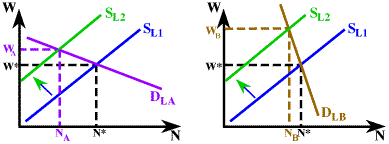

Copyright © 1995-2004 OnLineTexts.com, Inc. - All Rights Reserved

An increase in non-labor income will shift back the supply of labor to both industries. The leftmost of the two graphs shows the effect of the reduced supply for Industry A, and the right one shows the effect for industry B. Because output demand is elastic in industry A so is labor demand illustrated by the labor demand curve DLA. In industry B output demand is inelastic causing labor demand to be inelastic as well, illustrated by labor demand curve DLB. The result is that equal supply shifts from SL1 to SL2 have different results. In industry A numbers of workers hired drops dramatically and wages rise only slightly. In industry B wages increase dramatically and numbers hired drop only slightly.


Copyright © 1995-2004 OnLineTexts.com, Inc. - All Rights Reserved